
The Neon Sign Museum, the first in Canada, features a collection of historic signs that tell a story about Edmonton’s neon past.
The City of Edmonton has collected, restored and installed neon signs on the east wall of the TELUS building and the south wall of the Mercer Warehouse building on 104 Street and 104 Avenue.
The Museum is outdoors and is open 24 hours a day, 7 days a week. No admission is required.
Sign Collection
The signs chosen are iconic and represent the commercial signage from Edmonton’s history.
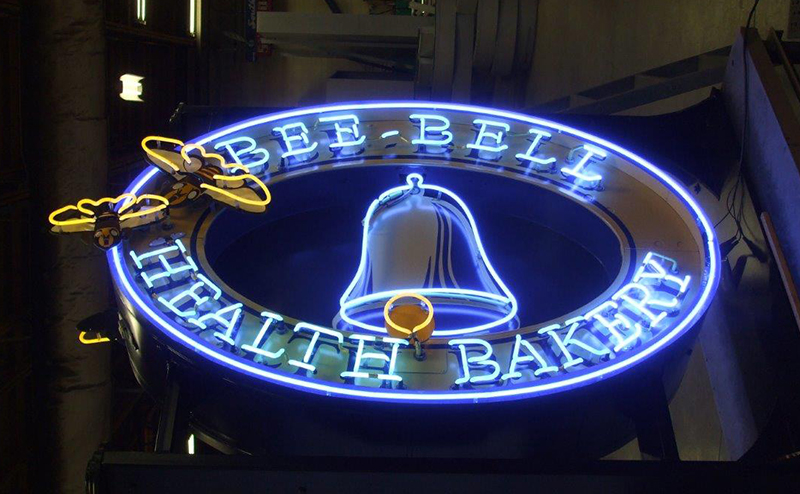
Bee-Bell Health Bakery
Bee-Bell Health Bakery, founded by Edwin Strimer and later owned by Janet Traub, became a baking institution in the city.
Sign donated by: Janet Traub
Sign restored by: Blanchett Neon Ltd.
Bee-Bell Health Bakery was founded in 1956 by Edwin Strimer. Its first location in Old Strathcona at 8124 - 103 Street was its home for 39 years. Mr. Strimer and his wife Elizabeth built what would become a baking institution in Edmonton.
In 1990, Leonard and Janet Traub became the new owners of Bee-Bell Health Bakery and became responsible for 33 full-time employees. The business continued smoothly until 1994 when the lease ended. Ms. Traub purchased 10416 - 80 Avenue from Sam Toronczyk, and in 1995, the Bee-Bell Health Bakery neon sign was erected at the new premises. The swinging neon bell was turned on at Easter and off after Thanksgiving due to Edmonton’s winter weather. The bell was well enjoyed by customers.
Bee-Bell continued to prosper in their new location. In 2006, Ms. Traub sold Bee-Bell Health Bakery with the intention of returning to full-time painting and went on to receive international recognition for her work. Regrettably, the bakery closed in 2013 after serving Edmonton for 57 years.

Call The Kettle Black
Call the Kettle Black set culinary trends and expanded the shopping experience for those with a passion for cooking.
Sign donated by: Randall MacDonald and Darcy Kaser
Sign restored by: Skyline Sign Services Ltd.
Call the Kettle Black was a local specialty kitchen shop which operated for two decades. Setting culinary trends since their first Edmonton store in 1996 in the Highstreet shopping area of 125 Street and 102 Avenue, Call the Kettle Black owners and operators Darcy Kaser and Randall MacDonald expanded the shopping experience for those with discriminating tastes, sophisticated palates and a passion for cooking. They travelled the world to find the most unique culinary tools and toys while offering a comfortable, friendly atmosphere and knowledgeable staff to give customers quality service and insightful information about the products.
This sign, used for the Highstreet location of Call the Kettle Black, was originally built by Blanchett Neon in 1994. Darcy and Randall opened their second location of Call the Kettle Black in Riverbend Square in 2006, and in 2009 expanded the company to include 3 locations in Vancouver: North Vancouver, Kerrisdale, and West 4th. In 2016, Call the Kettle Black closed down. Their 20 years in business left its impact which is still felt in both cities.
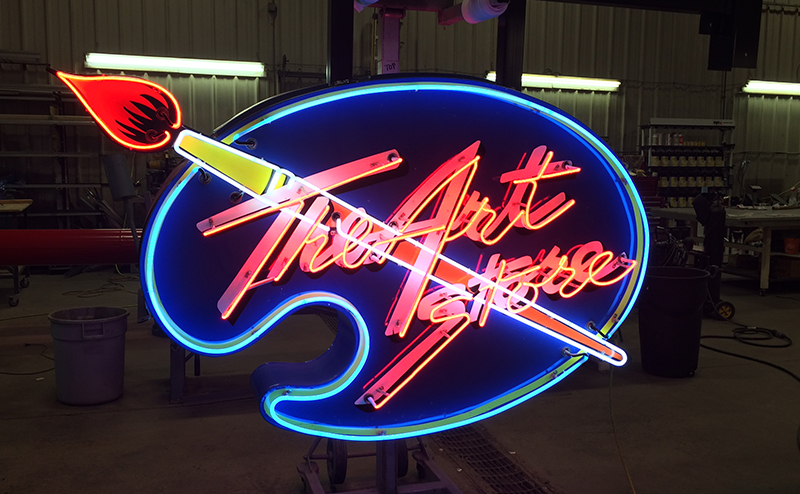
The Art Store
The Art Store sign was placed in storage for 30 years before being installed at the Neon Sign Museum.
Sign donated by: Janet Traub
Sign restored by: Skyline Sign Services Ltd.
The Art Store was an art supply store located at 10416 80 Avenue in Old Strathcona, founded in 1980 by artist and proprietor Janet Traub. Ms. Traub worked at the Woodward’s Bakery in the 1970s to put herself through art school, then set out to design a sign that would distinguish her establishment as a creative stop for her retail and wholesale customers.
Ms. Traub travelled extensively to high schools, colleges and universities throughout Alberta and Saskatchewan, assisting teachers and professors with their curriculum and art supply requirements. The tumultuous 1980s proved to be extremely hard times for businesses in Alberta. She ultimately sold The Art Store to Burlington Art and Drafting in 1987 in hopes of a more secure future.
Ms. Traub would not know of her eventual return to the premises at 10416 80 Avenue, where the second of her neon signs, Bee-Bell Health Bakery, would subsequently hang as part of her business starting in 1995.
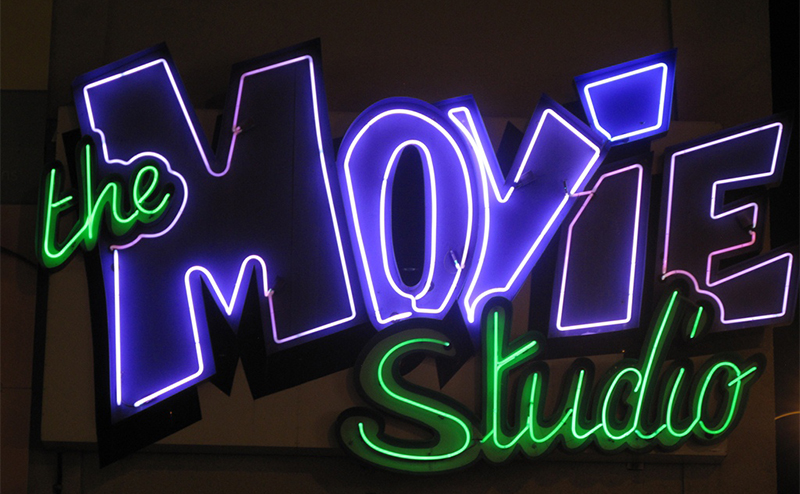
The Movie Studio
The Movie Studio sign featured a distinctive font using somewhat rare purple and green neon.
Sign donated by: Maclab Development Group
Sign restored by: City Image Signs
The Movie Studio, an independent supplier of home videos, opened its doors in 1997 and was a fixture on 109 Street for 18 years.
Known for its massive collection of movies, flexible late fees, free popcorn and friendly staff, The Movie Studio was always on the leading edge of technology successfully transitioning its library from VHS to DVDs to Blue-Ray. But the switch to high speed internet and on demand movies rendered local video stores obsolete and The Movie Studio closed its doors forever in May 2015.
The Movie Studio sign was made by Blanchett Neon and featured a distinctive font using somewhat rare purple and green neon.
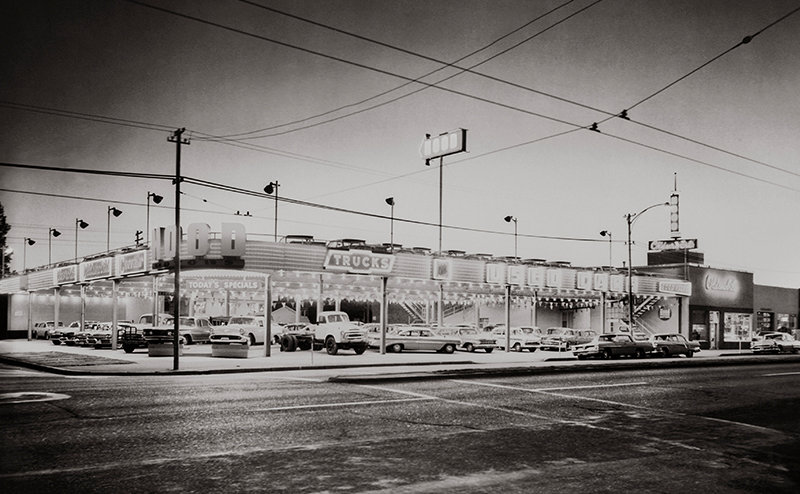
Chevy Bowtie Trucks
The Hood Motor Company was established by Gordon Hood in 1951 and opened in January 1952.
Sign donated by: Scott Caruth
Sign restored by: Skyline Sign Services Ltd.
The Hood Motor Company was established by Gordon Hood in 1951, although the building on Whyte Avenue and 107 Street was not completed until January 1952.
Mr. Hood, who was raised on a ranch near Castor, Alberta, came to Edmonton in 1936 after years working in auto body shops in south and central Alberta. The Whyte Avenue Oldsmobile and Chevy dealership and automotive shop soon became “the most complete car service shop in Edmonton”, according to the Edmonton Journal. In 1959, Hood Motors added an eye-catching double-decker show room to the dealership, which is probably when the Chevy Bowtie Trucks sign was added. Hood sold the company at the end of 1961 to the recently-arrived Don Wheaton, who was an experienced car dealer from Saskatchewan.
Don Wheaton’s dealership was the largest General Motors (GM) distributor in Western Canada. It was also one of Canada’s biggest sellers for Corvettes. GM eventually requested that Don Wheaton renovate its exterior design to a more modern appearance, similar to the standard corporate dealership exterior. Although the retro appearance of the Don Wheaton building maintained from Hood Motors was favoured by the neighbourhood, many of the neon signs were eventually removed, and the dealership’s exterior was renovated.
Don Wheaton retained some of their neon signs and placed one on the corner of 107 Street and Whyte Avenue. The remaining neon signs on the roof were kept in place.
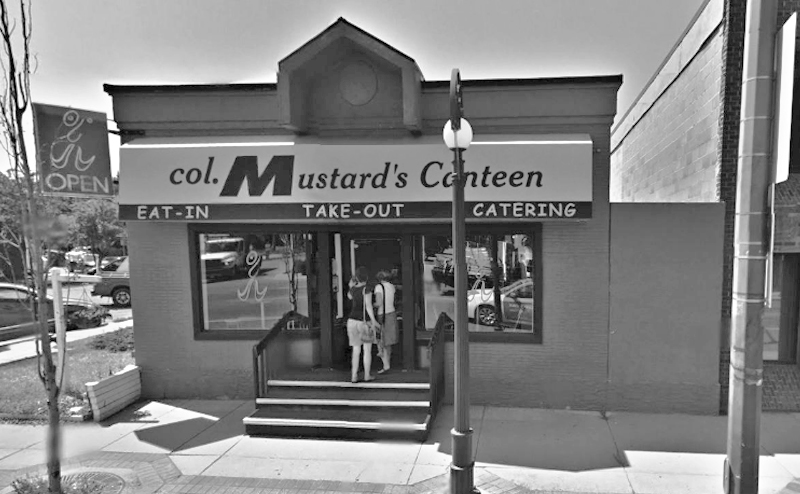
Colonel Mustard’s Canteen
Colonel Mustard’s Canteen operated successfully for 18 years and had a record day on its final day of operation.
Sign donated by: Brad and Carla Pipella
Sign restored by: Skyline Sign Services Ltd.
Colonel Mustard’s Canteen was first established in 1995 by Brad and Carla Pipella and was located on 124 Street.
Throughout the years, Colonel Mustard’s Canteen became a one-of-a-kind eating establishment and a landmark of 124 Street. In February 2012, a water main broke, which lead to the unexpected closure of Colonel Mustard’s Canteen. This also caused the unfortunate subsequent demolition of the building, which was built in 1950.
Although there were plans to reopen, due to multiple variables, Brad and Carla Pipella decided not to re-open the business.
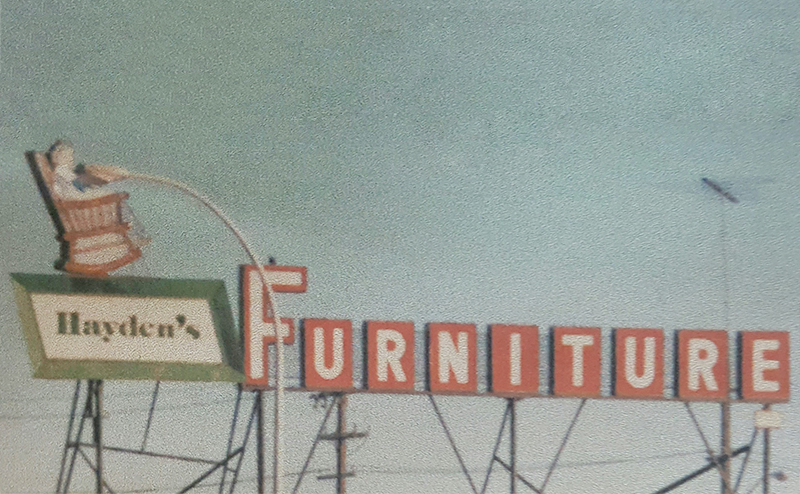
Hayden's Furniture
The Rocking Chair of Hayden's Furniture became a landmark in their early years of business.
Sign donated by: Blayne Wright
Sign restored by: Skyline Sign Services Ltd.
Marv Hayden opened his doors as “Marv Hayden's Furniture” in November 1964 at 10347 80 Avenue in Old Strathcona. Douglas Wright joined Hayden in the fall of 1966 and became a partner soon after. In 1968, the iconic rocking chair sign was created by Frank Demskie, Sharon Wright's father, of XL Neon Signs.
The Marv Hayden “Rocking Chair” became a landmark in the city of Edmonton. In the early years of business, the Grandma sat in the chair but would leave for a brief period of time for a rabbit during Easter and for Santa during Christmas. This ended in the mid 1970s, and Grandma stayed seated to greet people for the remaining years of the business.
Doug and Sharon Wright became sole owners in 1983, and their daughter, Jaime Eaton, joined the family business soon after. The name was changed to Hayden's Home Furnishings when the business moved locations to 10181 34 Avenue in 2002. Due to Grandma’s age, she required a little TLC prior to the move.
After a successful 49 and a half years, Doug and Sharon decided to retire and closed the doors in April of 2013. Their son, Blayne Wright, had the rocking chair, along with Grandma, removed and refurbished. Soon after, Blayne surprised the family without their knowledge by donating the sign to the Neon Sign Museum in 2016.
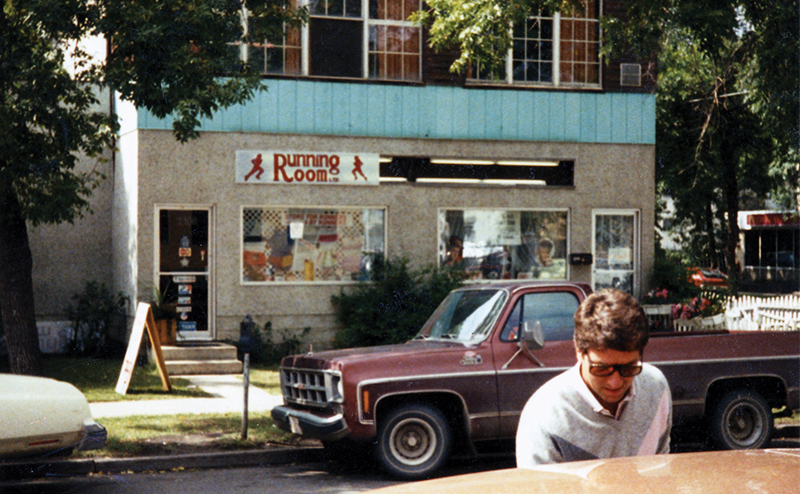
Running Room
Running Room originated in Edmonton in 1984 and is now North America's largest chain of specialty running stores.
Sign donated by: The Stanton Family
Sign restored by: Sign Force
Running Room originated in 1984 out of founder John Stanton’s wish to purchase quality running shoes from someone knowledgeable about the sport. Unable to find this, he decided to fill a niche in the marketplace by opening a small one-room store in the renovated living room of an old house in Edmonton (10150 – 112 Street), hence the name, “Running Room”.
The neon sign displayed in the Museum was initially installed in 1997 by Airlite Signs at the opening of Running Room at the Kinsmen Sports Centre. The sign incorporated the original company logo and evolved it into its now-familiar look. The Kinsmen store received major renovations in 2010, at which time the sign was removed and put into storage.
Managing partners John Stanton Jr. and Jason Stanton lead the operations of this Edmonton-based, family-owned company, which is now North America’s largest chain of specialty running stores, with over 100 locations across Canada and the United States. Running Room remains committed to building a true sense of community in each store location by supporting local charities through running and walking events, all the while continuing to provide runners a retail store “for Runners by Runners”.
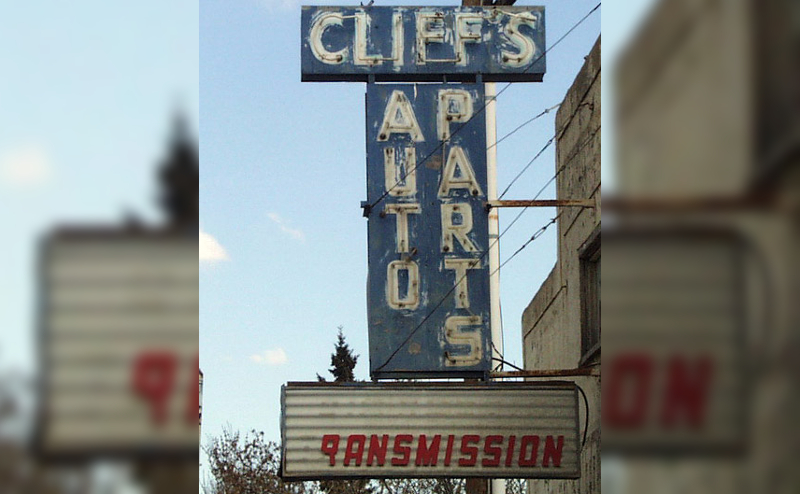
Cliff's Auto Parts
Cliff's Auto Parts and Wreckers operated at 9646 Jasper Avenue from 1959 until 1962.
Sign restored by: Advantage Signs
Auto wreckers and parts dealers have been Edmonton fixtures since soon after the first car first appeared on its streets.
Early car owners were often their own mechanics, since there were few of that trade in business before the Second World War. Even then, most mechanics were associated with automobile dealerships, and would usually service only what their company sold.
The need for wreckers and parts businesses increased greatly with the return of prosperity following the Second World War, the advent of the oil boom in 1947, and the demand among suburban dwellers for more cars and services.
Cliff's Auto Parts and Wreckers operated at 9646 Jasper Avenue from 1959 until 1962. William Choma was the proprietor, while Phillip Fath was the manager.
In 1962 Cliff's Transmission and Auto Parts moved to 10819B 101 Street. Cliff's Auto Parts also had a yard located in Riverdale by about 1963. Cliff's Transmission and Auto Parts moved again in 1967, to 10635 95 Street, and continued in operation until at least 1976.
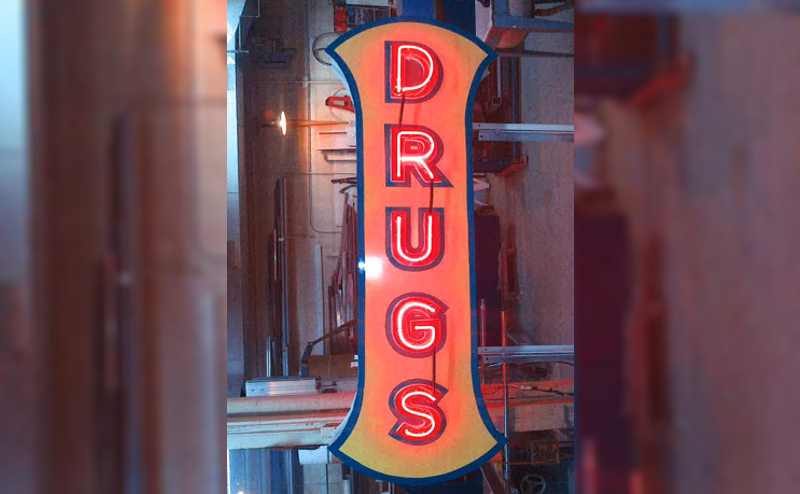
Drug Store Sign
The first neon sign in Edmonton was put up on Darling's Drug Store in 1928.
Sign restored by: City Neon
The first neon sign in Edmonton was put up on Darling's Drug Store in 1928. Such businesses have been among the most common sites for neon signs over the years.
This sign appears to have been discovered in the basement of the Stovel Block, constructed on Namayo Avenue (97 Street) in 1910. There is a story that the sign appeared originally on the Armstrong Drug Store, although this remains unconfirmed.
Armstrong Drug Store first opened on Namayo Avenue near Boyle Street (103 Avenue) in 1907. Armstrong Drugs offered its services to the public at this location for the next 9 decades.
George S. Armstrong, the owner, served as mayor of Edmonton and City Commissioner during 1912-1913. Between 1920 and 1950, M.J. Warner was the proprietor of Armstrong Drugs and Stationery. In 1950 George J. Andrews took over.
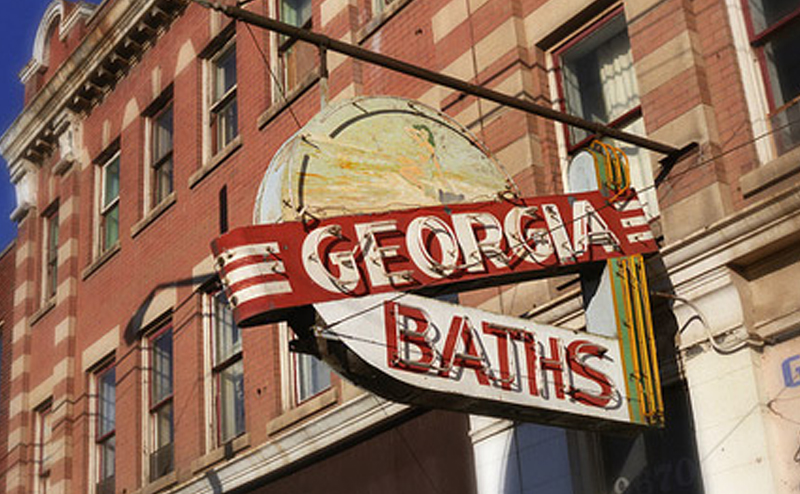
Georgia Baths
The Georgia Baths sign was a familiar sight along Jasper Avenue for many years.
Sign donated by: John Toma
Sign restored by: Skyline Sign Services Ltd.
This modest sign hung perpendicular to one of the city's iconic structures, the Flat Iron Building on Jasper Avenue and later on the Brighton Block, its neighbour to the west as the business changed locations.
Steam baths once were a common part of Edmonton life, popular with European immigrant groups and working men.
Edmonton Turkish Baths Limited opened for business in October 1913. Like today's health and beauty spas, bath facilities were considered very luxurious.
Luxurious Bath Facilities
Edmonton Turkish Baths boasted 13 large sleeping rooms, 2 large hot rooms (separate for each gender), a steam room, 3 shower baths, 6 tub baths, a barbershop, cigar stand, refreshments and shoeshine.
Turkish baths begin with a steam, followed by a soap rub, ending with a salt rub. The Edmonton Journal observed in 1913 that, "A new and elaborate Turkish Bath House has at last been established in the city to fill a long felt want for a city of the size and population of Edmonton ... located in the new Gibson block, one of Edmonton's high class structures, situated on Jasper Avenue at the point where Rice, Kinistino and Jasper converge..."
The Georgia Turkish Baths, a direct successor of the Edmonton Turkish Baths, would be the last such business to close in Edmonton in August 1991. It reopened briefly in 2004 as Steamers, but was again closed in November 2005. When it closed, Georgia Baths was known as "Edmonton's oldest public steam bath."
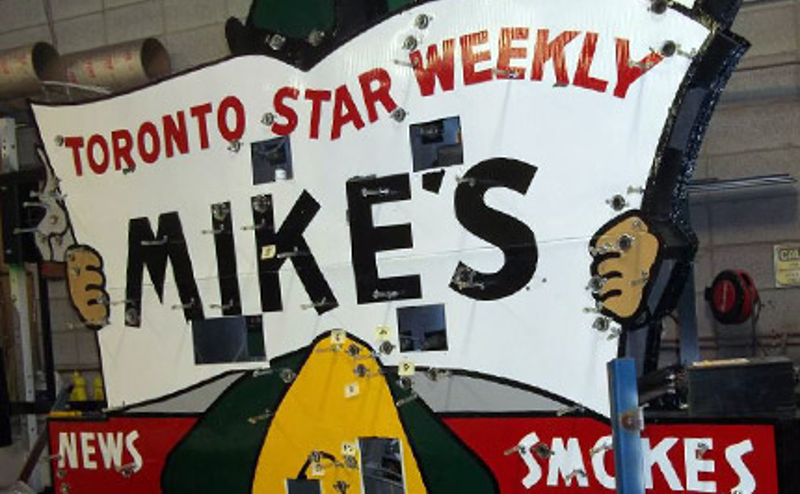
Mike's News
Mike's News carried on business as an Edmonton institution from 1912 until 1986.
Sign donated by: Mr. J MacDonald
Sign restored by: New Look Signs
Mike's News carried on business as an Edmonton institution from 1912 until 1986. Its distinctive sign, with the engrossed reader, his hat showing above his copy of the Toronto Star Weekly, and one crossed foot wagging away, was a landmark on Jasper Avenue from 1934 until it was removed in 1979.
The "newsstand" remained at 10062 Jasper Avenue for most of its life, until it was moved to 10119 101 Street in 1979, at which time the sign was donated to Fort Edmonton Park.
John "Mike" Michaels was also something of an Edmonton institution. He arrived in Edmonton from New York City in 1912, and began selling newspapers using a horse as transportation, and later a 4-wheeled vehicle powered by a motorcycle engine.
More Than a Newsstand
Michaels began by selling newspapers on the corner of First Street and Jasper Avenue after buying out Mickey Ryan and Walter Wolk, obtaining their busy spot to conduct his downtown newspaper vending business. His other claim to fame was the work he did with the Newsboys (usually underemployed adult males of various ages) who delivered the papers.
Mike assisted them with education, career advancement and social betterment through opportunities like the well-known Edmonton Newsboys Band, which played at many civic functions and even toured around Canada and Europe.
One of the few places where special orders could be requested from publishers around the globe, Mike's News was a popular community meeting place, more than simply a retail space.

Pantages Theatre
The Edmonton Bulletin heralded the Pantages as the "most northerly high class vaudeville play house in North America."
Sign donated by: Landale Signs
Sign restored by: Landale Signs
This sign hung on the Famous Players theatre on Jasper Avenue, formerly the Strand, and before that, the Pantages. The vertical sign once had a decorative illuminated "cascade" of lights over it, enhancing its first impression.
The sign was removed in 1964 and donated to the Archives and Landmarks Committee, forerunner of the Edmonton Historical Board. For many years the Pantages sign was attached to the southwest corner of the old City Archives Building.
Mayor William Short opened the Pantages Theatre at 10209 Jasper Avenue, to a packed house of 1,600 people, on May 12, 1913. It was the collaborative work of George Brown and fellow Greek immigrant, Alexander Pantages, the famous theatrical impresario and entrepreneur.
The Vaudeville Era Exits Off Stage, and Motion Pictures Enter
However, in 1921, under threat of insolvency, Brown announced that the theatre would reopen as a "motion picture house," spelling the end of the travelling vaudevillians in Edmonton.
Ten years later Alex Entwistle purchased the theatre, upgraded the sound system for the "talkies," and added the renamed Strand Theatre to his network of movie houses.
Some live events remained, as the Edmonton Little Theatre and local opera productions used the stage on occasion. Premier William Aberhart recorded his Edmonton Prophetic Bible Institute radio broadcasts in the Strand.
In 1953 the Strand was renovated, and 3 years later purchased by Famous Players. First Northern Building Corporation purchased the Strand in 1959. It was declared a Provincial Historic Resource in 1976, but dismantled in 1979.
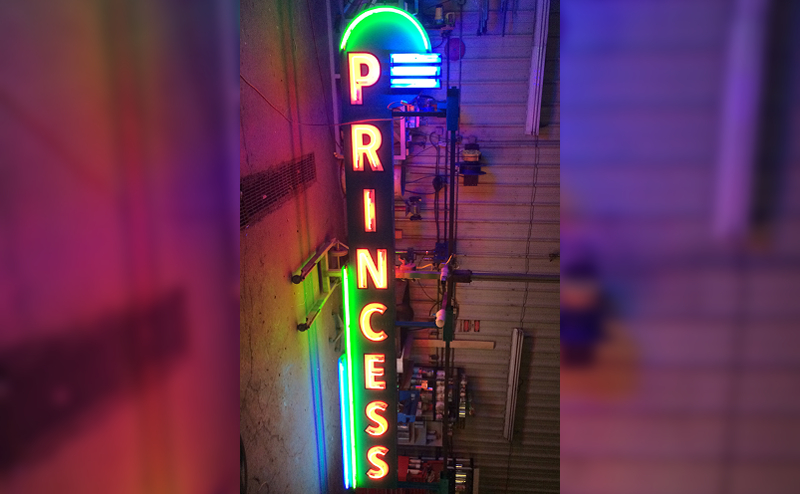
Princess Theatre
In addition to the horizontally oriented marquee, a vertically lit sign was added to the Princess Theatre in the 1940s.
Sign donated by: The City of Edmonton
Sign replicated by: Skyline Sign Services Ltd.
Theatres had to attract attention, not only to the building but also to the weekly features, and the Princess Theatre was no exception. Large signs and many lights were definite attention-grabbers. In addition to the horizontally oriented marquee, a vertically lit sign was added to the Princess Theatre in the 1940s. This original sign was done in an Art Deco style and was relatively short-lived as it was removed from the building on March 10, 1954.
Prominent Strathcona entrepreneur J.W. McKernan, who already operated two “photo-play” theatres on the south side, built the Princess Theatre between 1914 and 1915. It was designed by the architectural firm of Wilson and Herrald and constructed by Brown and Hargraves.
“Except for the name set in tiles and the copper cornice, the whole front of the three-storey building will be of marble,” the Edmonton Bulletin reported. “It will be the only marble-front building west of Winnipeg.”
The outbreak of the First World War and the resulting shortages of labour and materials postponed the opening until March 1915, despite the declaration on the date stone above the entrance, which indicates that the opening occurred in 1914.
The Princess Theatre closed in 1958 in the face of competition from television and other new entertainment opportunities. The Princess Theatre was purchased by Towne Cinemas in 1970 and then given a facelift before re-opening as the Klondike Cinema. The Princess was purchased by the Old Strathcona Foundation and was restored and re-opened in 1978 as a repertoire theatre.
The original sign is owned by the City of Edmonton. However, its condition did not lend itself to appropriate restoration for the Museum. The sign showcased in the Museum is a replica sign.
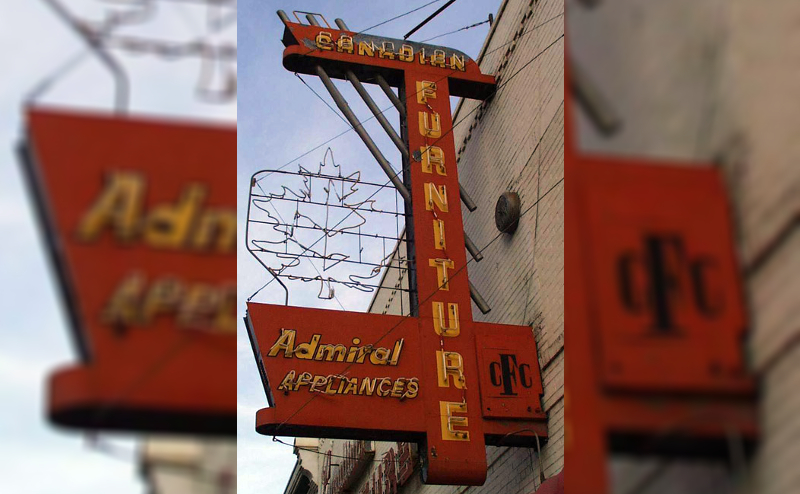
Canadian Furniture
The sign is a reminder of the vibrant commercial activity that grew in the city from the 1950s to the end of the millennium.
Sign donated by: Carol Dolinko
Sign restored by: Blanchett Neon
Furniture stores and "exchanges" were common in Edmonton beginning with the first immigration boom in the early 20th century. Many newcomers were on the move constantly as they settled into their latest home, while a large upwardly mobile segment of the population also felt the need to change their furnishings as they could afford them.
This created commercial opportunities that were specific to that time, but were also renewed with every wave of immigration during periods of increased economic activity in the city. Sam Dolinko's Edmonton Furniture Exchange was one such business.
More than 60 years in business
Samuel Dolinko was the proprietor of the business carried on under the names Canadian Furniture Store, Canadian Furniture Company and Canadian Furniture Exchange.
Sam Dolinko began working in Edmonton in 1933, during the height of the Great Depression. He opened Canadian Furniture Company store on 97 Street near 103 Avenue in 1936.
Sam and his wife Cila, and his son Max Dolinko, who managed the business and saw it expand after the 1970s, were the principal operators of the thriving business for decades. As one of Sam's grandsons noted, "My grandparents created the store; my father gave it life."
The company closed in January 1998, but only after serving Edmonton for close to 5 decades during its postwar growth and expansion.
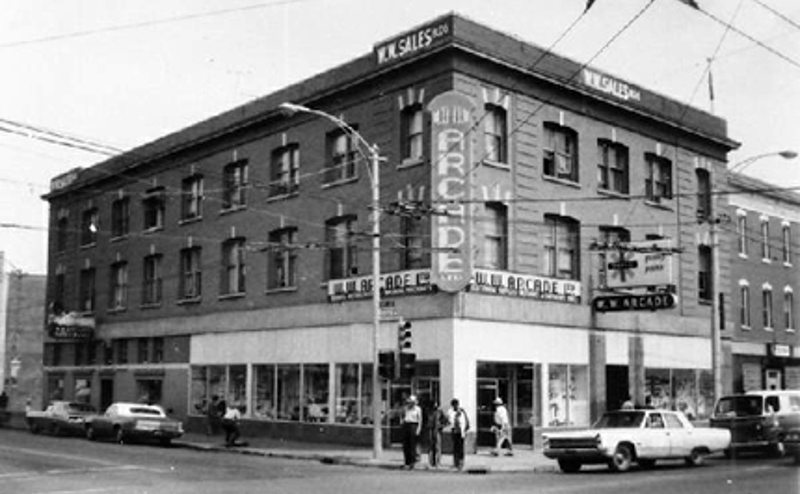
W.W. Arcade
The W.W. Arcade building was first known as the Goodridge Block, constructed on Jasper Avenue between 1911 and 1912.
Sign donated by: The Edmonton Downtown Corporation
Sign restored by: Hi Signs The Fath Group
The W.W. Arcade building was first known as the Goodridge Block, constructed for Leonard A. Goodridge at 9696 Jasper Avenue during 1911 and 1912, and designed by architect Robert Percy Barnes.
The ground floor at first housed a menswear store, barbershop, wine, liquor and cigar store, and pool hall, while the upper floors housed offices.
The Goodridge Block stood at a prominent location at the northeast corner of Jasper Avenue and Namayo (97th Street), during the corner's last years as the principal commercial intersection of the city.
In 1932 the main floor of the building was taken over by W.W. Sales Hardware, when Samuel P. Wilson purchased the property.
Wartime Name Change
During the Second World War, its name was changed to W.W. Arcade by the new owners, the Ainsley brothers (Alex, Bob and Dave), and this name lasted from 1942 until March 1991, when the business moved out of the main floor of the building.
The Edmonton Downtown Business Corporation received funding from the federal government to restore the Goodridge Block at the end of that year. The grand re-opening took place on April 15, 1993.
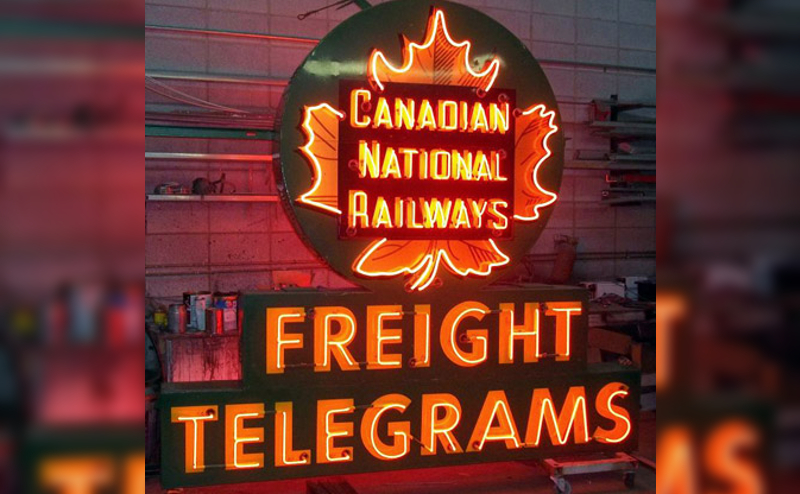
Canadian National Railway
The Canadian National Railways sign was placed on buildings in various cities to signify freight and telegraph services.
Sign donated by: Alberta Railway Museum
Sign restored by: Blanchett Neon
The Canadian National Railways (CNR) sign was placed on CNR buildings in various cities to signify the Freight and Telegraph services that the CNR provided.
The one we have was not on a building in Edmonton but was salvaged from a site in Calgary. It is typical of the railway signage used in larger cities like Edmonton, Calgary, Saskatoon and Winnipeg.
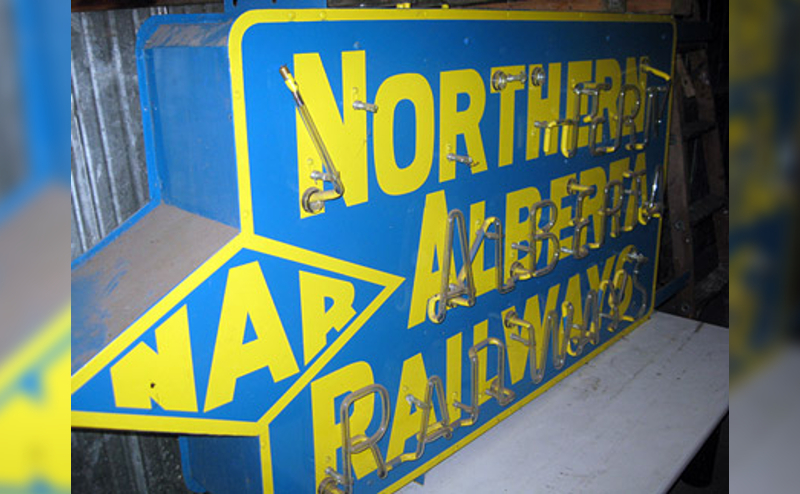
Northern Alberta Railways
The sign was on the Canadian Pacific Office building downtown on Jasper Avenue, which served as the Railways' headquarters.
Sign donated by: Alberta Railway Museum
Sign restored by: Blanchett Neon
The Northern Alberta Railways (NAR) were a conglomeration of a number of smaller railway companies which served the north of Alberta to move grain, silver, coal and other products south to link into the TransCanada rail system.
Composite members included the Edmonton, Dunvegan and British Columbia Railway, The Central Canada Railway, the Pembina Valley Railway, and the Alberta and the Great Waterways Railway.
In the 1920s most of these companies’ bonds were guaranteed by the Alberta Government, which eventually took them over, consolidated their operations and leased them to the Canadian Pacific Railway to run.
Corporate Changes Over the Years
In 1926, the operational agreement was transferred to the Canadian National Railway Company. By 1929, both the CPR and the CNR jointly owned and operated the NAR companies and worked together to build and maintain expansion to the lines in the north as needed. CN purchased the entire system in 1979.
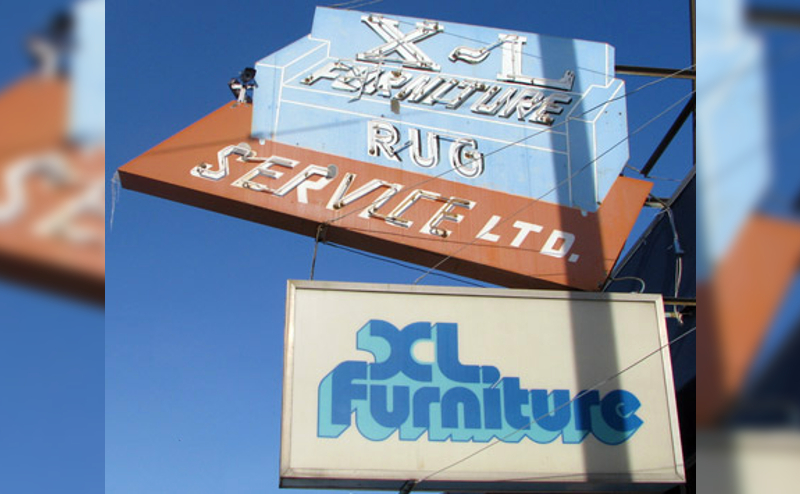
X-L Furniture
The iconic X-L Furniture sign was installed in 1961. It was repaired and repainted many times over the years.
Sign donated by: Mr. Al Struzynski
Sign restored by: PM Signs
The iconic neon X-L Furniture sign was installed in 1961. Rented from Blanchett Neon, for a monthly agreement of $32, this sign was repaired and repainted numerous times over the next 50-plus years.
In the early 1970s, the owner redesigned the logo, which was hung underneath the original neon sign, because complete replacement of the neon sign would have required (by City regulation) that the new sign be flush against the building, rather than projecting perpendicular.
Al Struzynski, the current owner, stated, "If it were not for that City regulation, the neon sign would not have survived to this day."
Store Capitalized on Post-war Prosperity
Edward 'Ed' Struzynski incorporated X-L Furniture, a carpet and furniture cleaning business in 1952 hoping to capitalize on the return of prosperity following World War II. He believed people would have the means to spend a little more of their income on home furnishings and upkeep.
After a successful start, Ed moved his business in 1955 to a better location (11349 - 95 Street) in Norwood. X-L Furniture settled in easily with the neighbourhood. However, in 1960, the single floor building with a wood floor burnt down.
The Struzynski family rebuilt a new 2-storey store (still present today as the centre bay of the store) the next year, and soon expanded their business to include furniture reupholstering, carpet and drapery sales and installations. The store was again expanded in 1972, when the north bay was built, doubling the size of the building, allowing for more furniture showroom space.
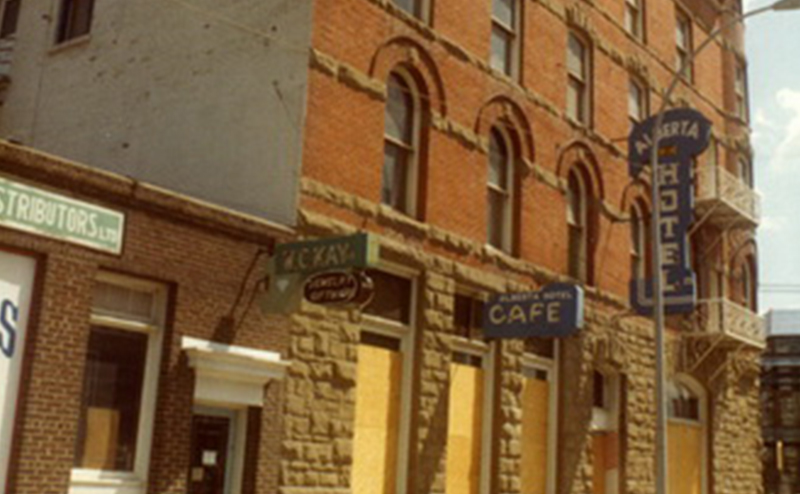
W. C. Kay Importers and Distributors
The 56-year-old W. C. Kay Importers and Distributors sign was lit up for the first time at the Neon Sign Museum.
Sign donated by: Randal Kay
Sign restored by: Skyline Sign Services Ltd.
In 1955, William (Bill) Kay opened as a local distributor in a 2,400 square foot building attached to the north end of the Alberta Hotel, located at 99 Street and Jasper Avenue.
Originally, W. C. Kay Importers and Distributors supplied small appliances to the W. W. Arcade, Eaton’s, Woodward’s, The Bay and Merit Stores. It expanded in the following years to offer luggage, giftware (such as crystal, figurines, clocks) and carded goods (such as lighters, cards, key chains). In 1963, the business increased its product line to include guitars, amplifiers, electric organs and gold jewellery. Business continued uninterrupted until 1980 when the property was sold, and the business was relocated to 10145 - 104 Street. At this time, the name of the business was changed to W. C. Gold, and Gem Merchants and the sign for W. C. Kay Importers and Distributors was displayed in the main showroom for 22 more years.
The sign was originally acquired in 1960 by negotiations with a gentleman shopping for an engagement ring. Though several attempts were made over the years, the sign was never actually hooked up to electricity. In 2016, arrangements were made to refurbish and mount the 56-year old sign on the wall of the Neon Sign Museum, which was the first time the sign was lit up.
Revitalizing The City
The Neon Sign Museum is part of the City's work to revitalize 104 Street. This process began over a decade ago with upgrading roadways and the streetscape, retaining historic buildings, and improving building facades and zoning to preserve the area's historic character.
The street began to flourish with new housing developments and the introduction of the City Centre Farmers Market. This special area is an example of how City investment, combined with community support, creates a catalyst for change and development.
The City is always looking for more signs for the museum from Edmonton and the surrounding region.
Restoring The Signs
The Alberta Sign Association generously organized the restoration of the signs. Several of their members, including Skyline Sign Services, Blanchett Neon, PM Signs, Advantage Signs, Landale Signs, City Neon, Hi Signs the Fath Group, General Signs, Newlook Signs and Sign Force, have committed staff and time to restore the signs.
The Neon Sign Museum is possible thanks to a partnership between the City of Edmonton, the Alberta Sign Association, TELUS, the Downtown Business Association and The Places.
Contact Us
David Johnston
Principal Heritage Planner
Email david.johnston2@edmonton.ca
Phone 780-496-5281
Fax 780-401-7052

